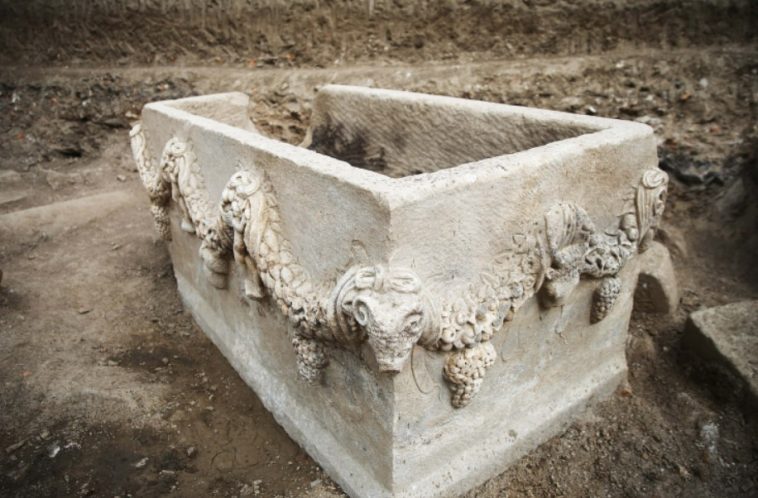From monumental tombs to ancient mosaics and shipwrecks, archaeological excavations across Turkey in 2025 have revealed treasures that shed light on the country’s vast cultural heritage. Supported by the Ministry of Culture and Tourism’s “Heritage for the Future Project”, these discoveries offer new insights into ancient civilizations that once thrived in Anatolia.
Known as an open-air museum, Turkey is home to countless archaeological sites where civilizations from the Neolithic Age to the Ottoman Empire left their mark. In 2025, ongoing excavations brought to light striking finds ranging from 2,700-year-old tombs and mosaics to statues, sarcophagi, and shipwrecks.
Here are the 10 most important archaeological discoveries in Turkey in 2025:
1. A 2,700-Year-Old Monumental Tomb in Gordion
In Ankara’s Gordion Ancient City, archaeologists uncovered a monumental cremation tomb dating back to the 8th century BCE, believed to belong to a Phrygian king or high-ranking noble. Known as the “47th Tumulus”, the burial mound measures 8 meters in height and 60 meters in diameter.
Despite collapsing over time, the wooden burial chamber preserved more than 100 bronze and iron artifacts, including large cauldrons, tripods, incense burners, and vessels. A 2,700-year-old bronze pot stands out as one of the key finds.
2. Hermes Statue Unearthed in Aspendos
Excavations at Aspendos Ancient City (Antalya) revealed a marble statue of Hermes, the messenger god of Greek mythology, dating to the late 2nd–early 3rd century CE.
The statue shows Hermes holding a money bag and caduceus, with a ram at his side. Standing 165 cm tall with its base, the work highlights the artistry of Roman sculptors. In the same area, fragments of statues of Aphrodite and Eros were also discovered.
3. Five Statues Found in Perge
At Perge Ancient City (Antalya), archaeologists discovered five statues, including a nearly 2-meter-tall statue of Aphrodite with Eros riding a dolphin.
Other finds include two dressed female statues from the Severan dynasty and a male-female statue pair unearthed on the city’s east street. These finds reflect Perge’s long-standing sculptural tradition and its role in ancient Roman culture.
4. A 2,200-Year-Old Mosaic and 1,800-Year-Old Tomb in Assos
In Assos Ancient City (Çanakkale), excavations revealed a 2,200-year-old Hellenistic mosaic decorated with floral and geometric motifs, possibly belonging to a gymnasium.
Additionally, an 1,800-year-old Roman mausoleum, likely belonging to an elite family, was uncovered. Together, these finds deepen our understanding of Assos’ cultural and artistic history.
5. 1,500-Year-Old Game Pieces in Hadrianopolis
At Hadrianopolis Ancient City (Karabük), two bone game pieces dating to the 5th century CE were discovered. The lentil- and disc-shaped tokens feature four- and eight-pointed symbols, suggesting their use in ancient strategy games like Ludus Latrunculi or Duodecim Scripta.
These finds emphasize the site’s history as a Roman military base, active from the 2nd to the 5th century CE.
6. Roman Animal Mosaics in Milas
In Herakleia Ancient City (Muğla), a former Roman bath repurposed as a barn by villagers revealed stunning floor mosaics depicting crocodiles, dolphins, flamingos, and eels.
The presence of crocodiles in Anatolia is unusual, suggesting the mosaicist may have traveled abroad and witnessed them firsthand. The imagery provides a fascinating glimpse into Roman art and imagination.
7. A 2,000-Year-Old Sarcophagus in Stratonikeia
In Stratonikeia Ancient City (Muğla), also known as the “City of Gladiators”, a richly decorated 2,000-year-old sarcophagus was uncovered.
The sarcophagus features garlands with ram heads, bull heads, Eros figures, and detailed motifs of olives, grapes, pomegranates, and poppies. Its fine craftsmanship reflects the wealth and status of the deceased.
8. “Mosaic House” Discovered in Pergamon
At Pergamon Ancient City (İzmir), archaeologists unearthed a Roman-era residential complex known as the “Mosaic House.”
Dating to the 2nd–3rd century CE, it features a central courtyard, fountain, and mosaic floors. Artifacts include a tombstone of a child with his dog, inscribed with the words “the sweetest child in the world.” The house remained in use during the Byzantine era but was destroyed in the 7th-century Arab raids.
9. Bronze Statue Fragments in Metropolis
At Metropolis Ancient City (İzmir), nearly 2,000 fragments of bronze statues were uncovered in what was likely an ancient recycling workshop.
Fragments include heads, eyes, fingers, and sandals, as well as bronze sheets used for casting. The discovery highlights both bronze production techniques and the importance of metal recycling in antiquity.
10. A 2,000-Year-Old Shipwreck in Adrasan
Off the coast of Adrasan (Antalya), underwater archaeologists discovered a shipwreck dating to the late Hellenistic–early Roman period.
Resting at a depth of 33–46 meters, the wreck contained hundreds of ceramic amphora fragments. These were carefully coated with clay and stacked to protect the cargo during transport. The discovery sheds light on ancient Mediterranean trade networks.
Conclusion
The discoveries of 2025 highlight Turkey’s unmatched archaeological wealth, with finds spanning from the Phrygians and Romans to the Byzantines. Each new excavation not only enriches our understanding of ancient civilizations but also strengthens Turkey’s position as a global center of archaeology and cultural tourism.

